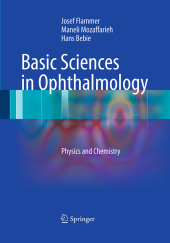 Neuerscheinungen 2016Stand: 2020-02-01 |
Schnellsuche
ISBN/Stichwort/Autor
|
Herderstraße 10
10625 Berlin
Tel.: 030 315 714 16
Fax 030 315 714 14
info@buchspektrum.de |

Hans Bebie, Josef Flammer, Maneli Mozaffarieh
(Beteiligte)
Basic Sciences in Ophthalmology
Physics and Chemistry
Softcover reprint of the original 1st ed. 2013. 2016. xv, 250 S. 45 SW-Abb., 396 Farbabb. 254 mm
Verlag/Jahr: SPRINGER, BERLIN; SPRINGER BERLIN HEIDELBERG 2016
ISBN: 3-662-50769-2 (3662507692)
Neue ISBN: 978-3-662-50769-8 (9783662507698)
Preis und Lieferzeit: Bitte klicken
Linking clinical ophthalmology to its basic science roots, this book reviews basic physics including the nature of light and its interaction with matter. The chemistry section covers organic and inorganic molecules, redox reactions and biological chemistry.
Basic Sciences in Ophthalmology aims to link clinical ophthalmology directly to its basic science roots. This first volume describes the physics and chemistry required for a sound understanding of modern ophthalmology. The book opens with an extensive discussion of the interaction of light with matter and the way in which light is used in ophthalmic examinations and treatments. After describing traditional methods of imaging, particular emphasis is placed on modern instrumentation such as OCT. The interaction between light and tissues in different types of laser treatment is also addressed. The chemistry section focuses on compounds particularly relevant to the eye, such as oxygen and water. The origin and consequences of oxidative stress are reviewed, and the physical behavior of chemical compounds in the eye is explained. Understanding is facilitated through the use of many examples taken from the field of ophthalmology. The text is complemented by about 450 figures.
What is light?- The interaction between light and matter.- Light sources.- Examinations with light.- Ultrasound diagnostics.- Further imaging procedures.- Interventions with laser light.- Some history of chemistry.- Oxygen.- Water.- Carbon dioxide (CO2).- Nitric oxide.- Redox reactions.- DNA.- RNA.- Proteins.- Lipids.- Matter: using water as an example.- If you are interested in more.- Appendix: Units and constants.
"The text is accompanied by beautiful, concise illustrations (by Natasa Cmiljanovic, Rebekka Heeb and Peter Räber) that are of great value in conveying the main points. ... this is a book worth having and consulting when you wish to be reminded of the fundamentals ... ." (Shiri Diskin, Graefe´s Archive for Clinical and Experimental Ophthalmology, Vol. 255, 2017)


